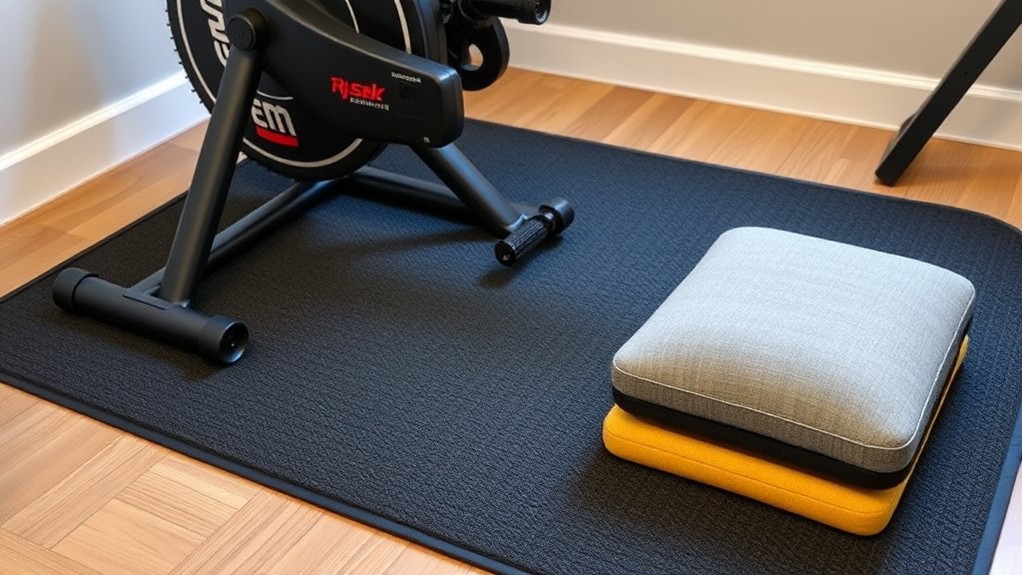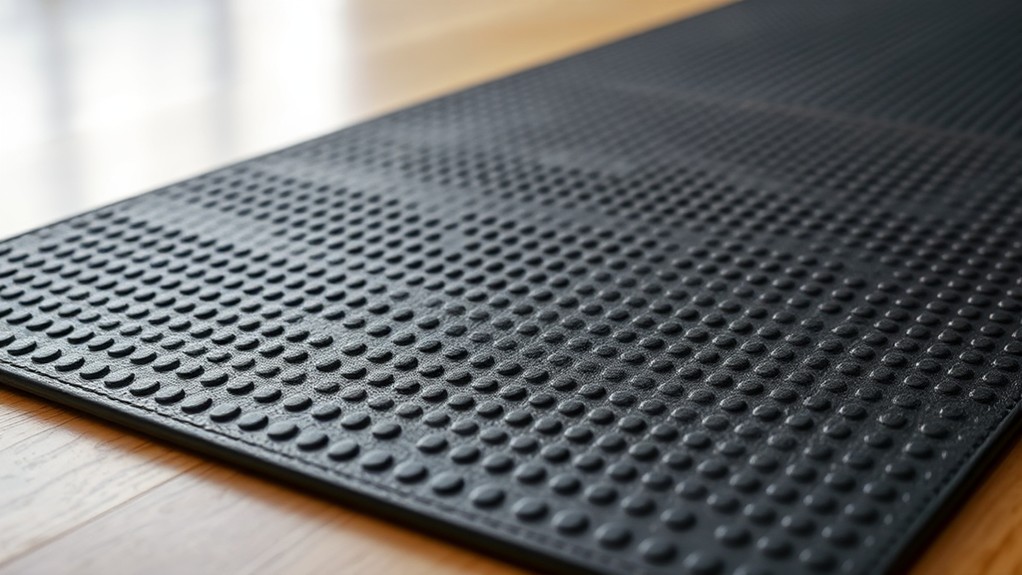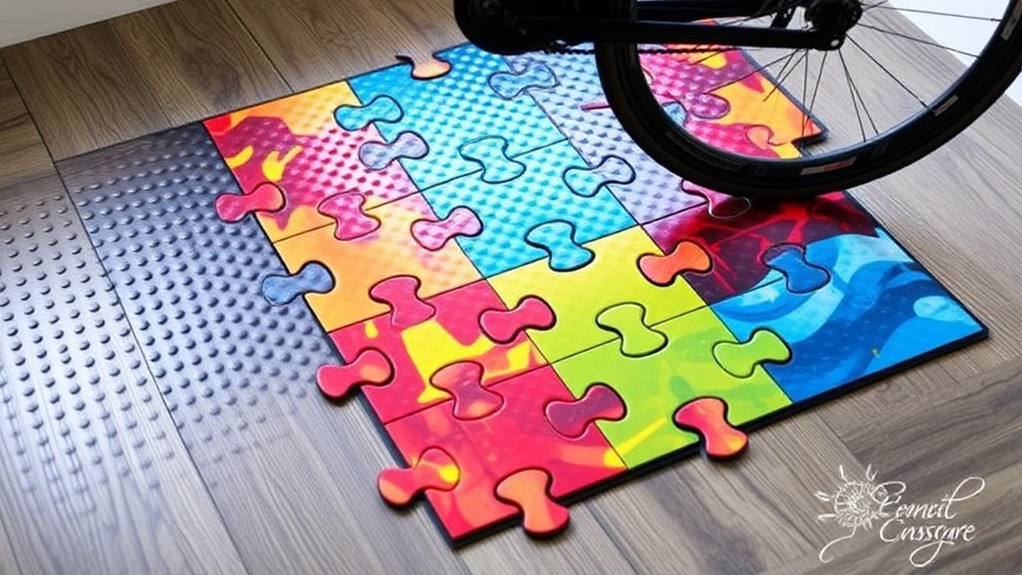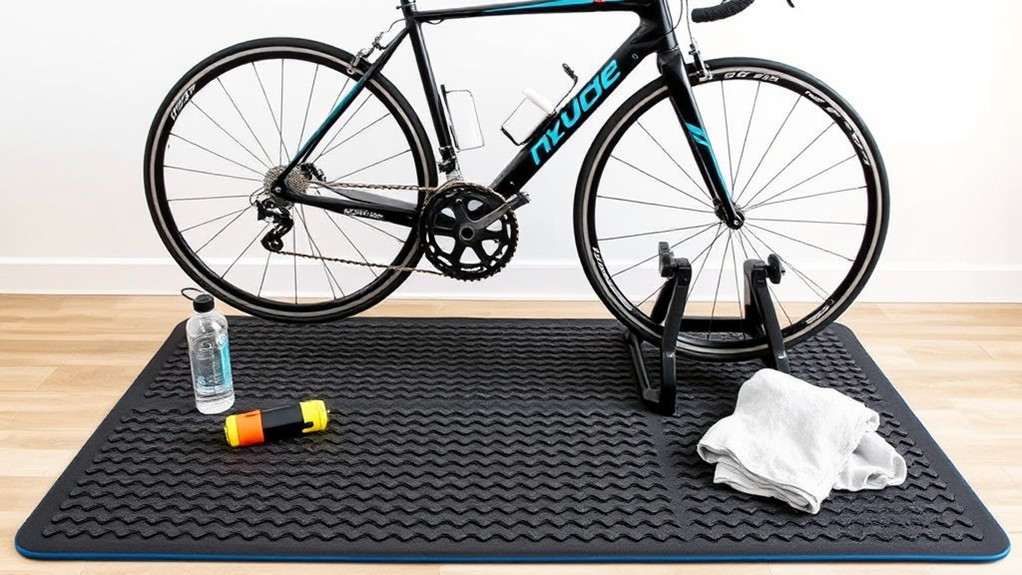Protect your floors during turbo training by investing in a high-quality turbo trainer mat. These mats safeguard your floors from vibrations, sweat, and noise. Look for mats that are at least 6mm thick, water-resistant, and have an anti-slip texture for stability. Thick mats likewise absorb sound and vibrations, creating a quieter training environment, especially in shared spaces. Regularly clean your mat to maintain hygiene and extend its lifespan. By using the right mat, you'll prevent costly floor damage and improve your indoor cycling experience. Keep reading to learn more about choosing the perfect turbo training mat for your needs.
Importance of Turbo Training Mats
One of the primary reasons to use turbo training mats is to safeguard your floor during intense indoor cycling sessions. These mats are designed with durable, water-resistant materials that can withstand the constant vibrations and sweat from your workouts, extending the life of your floors.
Many mats feature non-slip surfaces, which improve stability and reduce the risk of accidents from slipping equipment.
The noise insulation capabilities of turbo training mats likewise help to create a quieter training environment, especially beneficial if you live in a shared space.
Plus, the thick cushioning provides added comfort during your cycling sessions, which can boost your comprehensive workout performance and enjoyment.
When selecting a turbo training mat, look for one made from high-quality, easy-to-clean materials. This will guarantee a hygienic workout area and allow you to focus on your training without worrying about damage to your floors.
Investing in a reliable turbo training mat is a smart way to protect your space and get the most out of your indoor cycling workouts.
Factors to Consider When Choosing a Mat
When selecting a turbo training mat, consider its thickness. Mats around 6mm thick provide adequate cushioning to protect both floors and equipment during intense workouts.
Look for water-resistant materials that can handle sweat and spills, ensuring longevity and hygiene of the mat.
Next, opt for mats with an anti-slip texture to improve stability during cycling sessions and prevent movement of the equipment. This is vital for your safety and the stability of your turbo trainer.
Furthermore, evaluate the mat's noise insulation capabilities. Mats designed to muffle sound can greatly reduce disturbances in shared living spaces, making your workouts more considerate of others.
Lastly, choose mats that are lightweight and portable for easy storage and transport, facilitating a versatile workout space. This flexibility allows you to create the ideal training environment, whether you're at home or on the go.
Noise and Vibration Reduction

Protecting your floor from the intense vibrations and noise of turbo training is crucial. Using a thick, at least 2-inch gym mat under your trainer can greatly reduce the sound and vibrations transmitted to the floor, preventing disturbances in shared living spaces.
For even better sound absorption and vibration dampening, consider layering materials like rubber mats and carpet tiles.
Direct drive smart trainers, such as the Tacx Neo and Saris H3, are designed to operate quietly and produce less vibration, making them ideal for apartment living where noise is a concern.
You can likewise place your trainer on rubber mats specifically made for washing machines to help absorb those bothersome vibrations.
Be mindful of your training schedule and try to avoid noisy sessions during quiet hours.
With the right setup and techniques, you can minimize noise and vibrations, fostering better relationships with your neighbors and creating a more peaceful training environment.
Sweat and Moisture Protection
A dedicated turbo trainer mat, such as the Tacx Foldable Trainer Mat, can effectively absorb sweat, preventing damage to your floors and reducing noise during indoor cycling sessions.
Mats designed for indoor cycling, like the Van Rysel Turbo Training Mat, are typically made from water-resistant materials that protect against moisture and prevent corrosion from sweat.
Regular cleaning is crucial to maintain hygiene and prevent odors, as sweat can accumulate and create a breeding ground for bacteria.
The mat's thickness, such as the 6mm offered by the Van Rysel Turbo Training Mat, not only provides cushioning but additionally improves moisture absorption, reducing the risk of floor damage.
Investing in a high-quality mat can save you money in the long run by protecting your flooring from potential stains and wear caused by sweat during intense training sessions.
Stability and Non-Slip Surfaces

Opting for mats with an anti-slip texture, such as those made from heavy-duty EVA foam, can greatly improve stability and prevent your equipment from shifting during intense turbo training sessions.
Look for mats designed specifically for exercise equipment, which often feature tiny pads on the underside to minimize slippage and boost static stability.
A non-slip surface is essential for reducing the risk of injuries associated with sudden movements during high-intensity cycling workouts.
Confirm your mat is thick enough, around 6mm or more, to provide cushioning that protects the floor and improves your comfort and stability.
For optimal performance, choose a mat that absorbs vibrations and noise, as this dual functionality contributes to a more stable and quieter training environment.
The surface texture of your mat plays a key role in maintaining a secure grip, so select one that offers superior traction to keep your equipment firmly in place.
Customizing Mat Size and Fit
When customizing mat size and fit for your turbo training setup, start by measuring the area where your trainer will be positioned.
Standard bike training mats typically range from 152cm to 190cm in length and 70cm to 90cm in width, providing a variety of mat dimensions to suit your space requirements.
For a tailored coverage solution, opt for mats that can be trimmed or customized. This will guarantee the mat adequately covers both your trainer and any surrounding equipment, creating a snug fit.
To improve cushioning and stability, consider adding extra layers of foam or using offcuts from thicker mats.
Remember to select a mat with an anti-slip texture to prevent movement during intense sessions, maintaining its fit and effectiveness over time.
Budget-Friendly Floor Protection Options

If you're working with a limited budget, consider looking into budget-friendly options to protect your floors during turbo training. Carpet offcuts from local shops can provide a cost-effective solution, allowing you to customize the size and coverage to fit your needs. Exercise machine mats from retailers like Sports Direct are another excellent option, often available for under £20 and offering reliable protection.
For a flexible and budget-friendly choice, consider yoga mats, though verify they fit your equipment properly. Foam-backed lino from home improvement stores can likewise be a stable and sweat-resistant alternative at reasonable prices. And don't forget DIY solutions, such as layering old sleeping mats or combining different materials to create custom floor protection on a shoestring budget.
| Options | Cost | Pros | Cons |
|---|---|---|---|
| Carpet Offcuts | Inexpensive | Customizable, Durable | Limited Availability |
| Exercise Machine Mats | Under £20 | Effective Protection | May Not Fit Perfectly |
| Yoga Mats | Cost-Effective | Versatile | Potentially Narrower |
| Foam-Backed Lino | Reasonable Prices | Stable, Sweat-Resistant | May Require Cutting to Size |
| DIY Solutions | Minimal Cost | Customizable | Requires Time and Effort |
Maintaining Mat Cleanliness and Longevity
Regularly wipe down your mat with a damp cloth after each workout to prevent sweat buildup and maintain hygiene, guaranteeing a cleaner workout environment.
Choose mats made from water-resistant materials, as these are easier to clean and less likely to absorb moisture that can lead to odors and degradation.
When not in use, store your mat in a cool, dry place to prevent mold and mildew growth, which can occur in damp environments.
Consider using a mat with a sweat-resistant design to improve durability and prolong its lifespan, helping it withstand frequent use.
Regularly inspect your mat for any signs of wear and tear, and replace it as needed to maintain continued protection for your floors and safety during workouts.
Transitioning From Outdoor to Indoor Cycling

Transitioning from outdoor cycling to indoor turbo training often requires adjusting to the increased intensity and sweat production associated with indoor sessions.
While outdoor rides may feel more free and exhilarating, the controlled environment of the home gym brings its own benefits, including improved training consistency and efficiency.
However, the extra perspiration can pose a threat to your flooring, making proper protection a necessity.
To safeguard your space, invest in a high-quality trainer mat, such as the Tacx Foldable Trainer Mat or the Van Rysel Turbo Training Mat.
These specialized mats absorb vibrations and shield your floors from sweat and scratches.
Pair your mat with a non-slip design to maintain stability and safety during your indoor sessions.
For added protection, consider using a sweat catcher or towel to keep both your bike and floor dry.
Regular cleaning and maintenance of your mat will guarantee its longevity and continued effectiveness in preserving your space.
Pairing Mats With Cycling Equipment
Pairing the right mat with your cycling equipment is key to protecting your floors during vigorous turbo training sessions.
Opt for a dedicated training mat like the Tacx Foldable Trainer Mat, designed to absorb vibrations and shield against sweat damage. The 6mm thick Van Rysel Turbo Training Mat Flanders acts as a sturdy barrier, safeguarding both your floors and equipment.
The anti-slip texture of mats, such as the Wahoo KICKR Mat, improves stability during intense workouts, minimizing the risk of your setup shifting.
For apartment dwellers, a high-density mat can greatly reduce noise levels, making your training more discreet. Consider the 190cm x 90cm Van Rysel Mat to provide ample coverage for your cycling gear.
Prioritize mat materials and design aesthetics that suit your needs and space.
With the right pairing, you can train with confidence, preserving your floors and equipment for years to come.
Frequently Asked Questions
Can I Put My Bike Trainer on Carpet?
You shouldn't put your bike trainer directly on carpet. It'll lack stability and damage the carpet over time. Use a protective mat or hard, flat surface to guarantee your trainer's secure and your carpet stays protected.
How to Protect Floors When Moving In?
Use floor mats and furniture sliders to protect your floors when moving heavy exercise equipment. This'll shield your floors from scratches, scuffs, and damage during the relocation process.
How to Protect Wood Floor From Treadmill?
Use treadmill mats to protect your wood floor from damage. They'll absorb vibrations, prevent scratches, and cushion your workout. Keep the mat clean and check for debris to maintain your floor's condition.
Can You Workout on a Wood Floor?
You can workout on a wood floor, but you'll need to protect it from floor damage. Use workout equipment mats to absorb impact and prevent scratches from your exercise routine.
